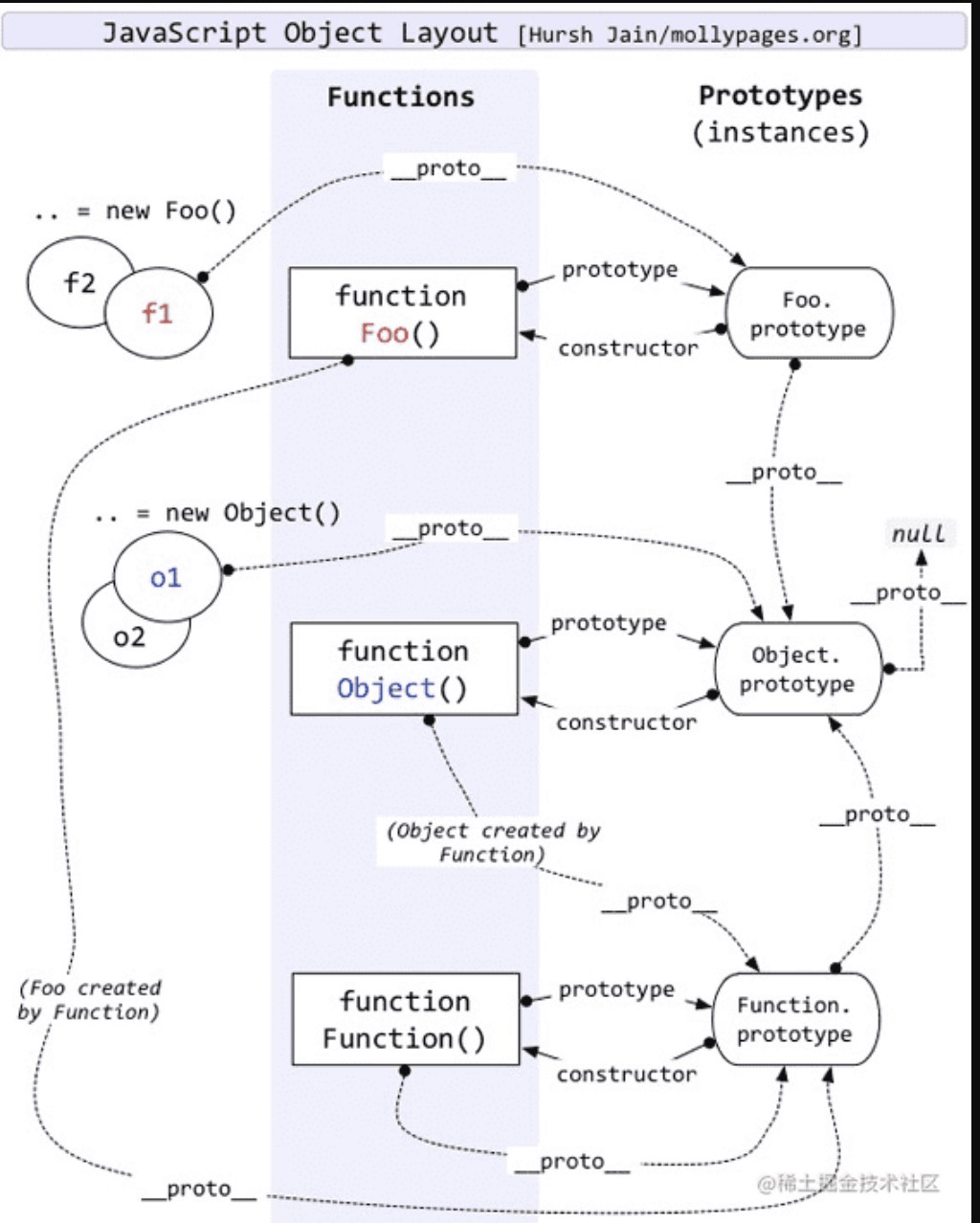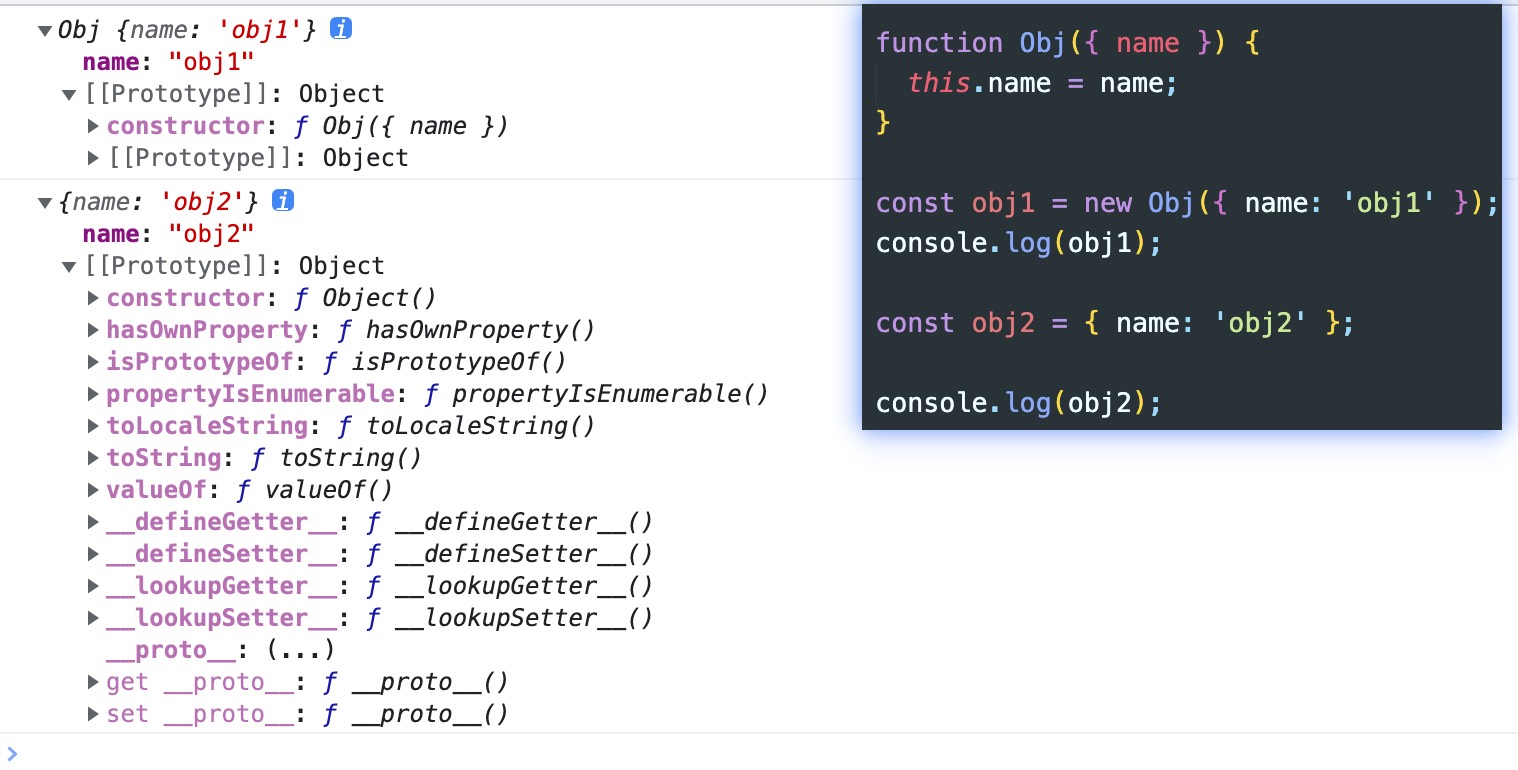原型一把梭
- 为什么
typeof判断null是Object类型; Function和Object是什么关系;new关键字具体做了什么? 手写?;prototype和__proto__是什么关系? 什么情况下相等?- ES5 实现继承有几种方式, 优缺点?
- ES6 如何实现一个类
- ES6
extends关键字实现原理?

- function Foo 就是一个方法, 比如js 内置的 Array, String 等
- function Object 就是一个 Object
- function Function 就是一个 Function
- 以上都是 function, 所以
.__proto__都是Function.prototype
函数对象和普通对象

从上面我们可以看出, 函数对象和普通对象都是对象, 却存在差异.
其实在 js 中, 我们将对象分为函数对象和普通对象. 所谓函数对象, 其实就是 js 的用函数来模拟的类实现, js 中的 Object, Function 就是典型的函数对象.
function fn1() {};
const fn2 = function() {};
const fn3 = new Function('name', 'console.log(name);');
const obj1 = {};
const obj2 = new Object();
const obj3 = new fn1();
const obj4 = new new Function();
typeof Object; // function
typeof Function; // function
typeof fn1; // function
typeof fn2; // function
typeof fn3; // function
typeof obj1; // object
typeof obj2; // object
typeof obj3; // object
typeof obj4; // object
可以看出, 所有 Function 的实例都是函数对象, 其他的均为普通对象, 包括Function实例的实例, 也就是函数对象
Function.__proto__ === Function.prototype
js 中万物皆对象, 而对象皆出自构造函数.
__proto__
首先我们要明确两点: 1.
__proto__,constructor都是对象独有的; 2.prototype是函数独有的
但是在 js 中, 函数也是对象, 所以函数也拥有 __proto__, constructor.
// 子.__proto__ === 父.prototype.
const fn1 = new Function();
const fn2 = new fn1();
fn2.__proto__ === fn1.prototype; // true
fn1.__proto__ === Function.prototype; // true
constructor
constructor 属性也是对象所拥有的, 它是一个对象指向一个函数, 这个函数就是该对象的构造函数
每一个对象都有其构造函数, 本身或继承而来. 单从
constructor这个属性来讲, 只有prototype对象才有. 每个函数在创建的时候, js 会同时创建一个该函数对应的prototype对象, 而函数创建的对象.__proto__ === 该函数.prototype, 该函数.prototype.constructor === 该函数本身, 所以通过函数创建的对象即使自己没有constructor属性, 也能通过__proto__找到对应的constructor, 所以任何对象最终都可以找到其对应的构造函数.
唯一特殊的就是 Function, js 原型的老祖宗, 它是他自己的构造函数. 所以 Function.prototype === Function.__proto__:
Function.prototype.__proto__ === Object.prototype; // true
Function.__proto__.__proto__ === Object.prototype; // true
Function.__proto__ === Function.prototype; // true
typeof && instanceof
基本用法
typeof 支持的类型:
- undefined
- boolean
- number
- bigint
- string
- symbol
- function
typeof 其他任何对象 === 'object'
typeof new String('cqc'); // object
typeof null; // object 这是 js 设计的一个 bug
instanceof
instanceof 可以判断一个实例是否是其父类型或者祖先类型的实例
object instanceof constructor
instanceof 和 typeof 非常类似, instanceof 运算符 用来检测 constructor.prototype 是否存在于参数 object 原型链上
基本用法
const C = function () {};
const D = function () {};
const o = new C();
o instanceof C; // true
o instanceof D; // false
o instanceof Object; // true, 因为 Object.prototype.isPrototypeOf(o) === true
C.prototype instanceof Object; // true, 同上
C.prototype = {};
o instanceof C; // false, C.prototype 指向了一个空对象,这个空对象不在 o 的原型链上
D.prototype = new C();
const o2 = new D();
o2 instanceof C; // true
Object instanceof Object; // true
Function instanceof Function; // true
Function instanceof Object; // true
Number instanceof Number; // false
String instanceof String; // false
为什么Function | Object instance of 自己成立, 而其他类 instance of 自己不成立呢?
const myInstanceof = function(target, model) {
const proto = model.prototype;
target = target.__proto__;
while(true) {
if(target === null) {
return false
} else if(target === proto) {
return true
}
target = target.__proto__;
}
}
new 关键字
new 都干了啥?
function Person(name) {
this.name = name;
}
Person.prototype.isHandsome = true;
Person.prototype.sayHi = function () {
console.log('hihihi');
};
const cqc = new Person('cqc');
cqc.isHandsome; // true
cqc.sayHi(); // hihihi
new 手写
const _new = function (constructor, ...args) {
if (typeof constructor !== "function") {
throw "constructor 必须是一个方法";
}
const newObj = Object.create(constructor.prototype);
const value = constructor.apply(newObj, args);
// 如果构造函数有返回值,那么只返回构造函数返回的对象。
return value instanceof Object ? value : newObj;
};
const cqc = _new(Person, 'cqc');
手写Promise
class MyPromise {
state: 'pending' | 'fulfilled' | 'rejected' = 'pending';
successTask: ((any) => any)[];
failTask: ((any) => any)[];
data: any;
err: any;
constructor(fn) {
this.successTask = [];
this.failTask = [];
const resolve = (v) => {
if (this.state === 'pending') {
this.state = 'fulfilled';
this.data = v;
setTimeout(() => {
this.successTask.map((o) => o(v));
});
}
};
const reject = (err) => {
if (this.state === 'pending') {
this.state = 'rejected';
this.err = err;
setTimeout(() => {
this.failTask.map((o) => o(err));
});
}
};
try {
fn(resolve, reject);
} catch (error) {
reject(error);
}
}
then(resolve: ((any) => any) | null, reject?: (any) => any) {
return new MyPromise((_resolve, _reject) => {
resolve &&
this.successTask.push(() => {
const res = resolve(this.data);
if (res instanceof MyPromise) {
res.then(_resolve, _reject);
} else {
_resolve(this.data);
}
});
reject &&
this.failTask.push(() => {
const res = reject(this.err);
if (res instanceof MyPromise) {
res.then(_resolve, _reject);
} else {
_reject(this.err);
}
});
});
}
catch(fn) {
return this.then(null, fn);
}
static resolve(v) {
return new MyPromise((r) => r(v));
}
static reject(err) {
return new MyPromise((r, j) => j(err));
}
}
事件轮询
js 中, 所有任务可以分为宏任务和微任务两种
- 宏任务: 在主线程上排队执行的任务, 只有前一个任务执行完毕, 才能执行下一个任务
- script, setTimeout, setInterval 等都属于宏任务
- 微任务: 不进入主线程, 而进入 微任务列表 的任务
- Promise, MutationObserver
事件轮询过程
- 代码执行过程中, 宏任务和微任务放在不同的任务队列中
- 当某个宏任务执行完后, 会查看微任务队列是否有任务, 如果有, 执行微任务队列中的所有任务
- 微任务队列执行完成后, 会读取任务队列中的第一个宏任务(注意宏任务是一个个取), 执行该宏任务, 如果执行过程中, 遇到微任务, 依次加入微任务队列
- 宏任务执行完成后, 再次读取微任务队列中的任务, 依次类推
Promise.resolve()
.then(function () {
console.log('promise0');
})
.then(function () {
console.log('promise5');
});
setTimeout(() => {
console.log('timer1');
Promise.resolve().then(function () {
console.log('promise2');
});
Promise.resolve().then(function () {
console.log('promise4');
});
}, 0);
setTimeout(() => {
console.log('timer2');
Promise.resolve().then(function () {
console.log('promise3');
});
}, 0);
Promise.resolve().then(function () {
console.log('promise1');
});
console.log('start');
/**
* start
* promise0
* promise1
* promise5
*
* timer1
* promise2
* promise4
*
* timer2
* promise3
*/